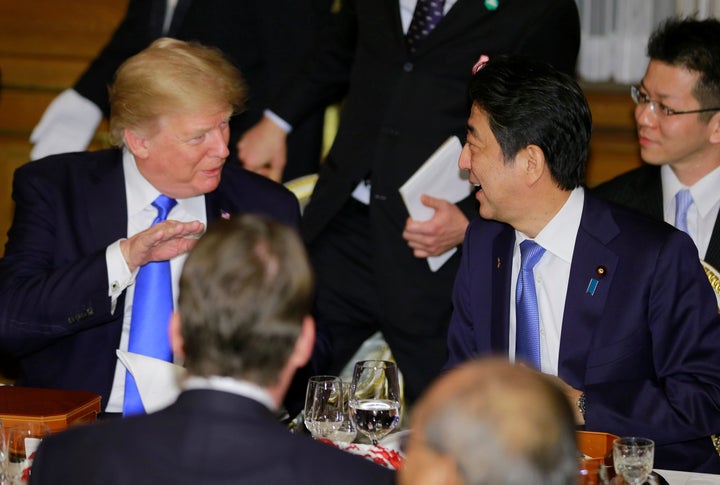
WASHINGTON ― Lower trade barriers. Better protections for intellectual property. More banking transparency.
Those were some of the provisions in the Trans-Pacific Partnership, negotiated by the Obama administration, that Donald Trump bashed on the campaign trail and then withdrew from days after becoming president.
Ten months later, as Trump heads to Vietnam during his trip to Asia, the White House says it is hoping to achieve these goals: Lower trade barriers. Better protections for intellectual property. More banking transparency.
The contradiction exemplifies the muddled U.S. policy that is sending mixed signals to trading partners and already encouraging European nations to jump in and fill the void.
“If you’re suggesting that there’s hypocrisy in the Trump administration, that’s not really new,” said Jared Bernstein, once the top economic adviser to former Vice President Joe Biden. “There’s always been a tension in the administration between the status quo group and those that are more protectionist. One of those two groups tends to prevail at any given time, depending on what’s in the news and what the president is tweeting.”
Senior Trump administration officials, speaking on condition of anonymity, defended the move as consistent with Trump’s desire to have multiple, one-on-one trade deals with countries, rather than a single agreement like TPP, which included a dozen nations.
“[Trump’s] own experience before he was in politics gave him a very firm conviction that on a bilateral basis, he would be able to achieve higher standards and better terms for American workers and for American business,” one official said.
In any event, a second administration official said, TPP was never going to be ratified: “I think that many lose sight that TPP was not supported by the Congress, and, in its form, it was not going to pass the U.S. Congress.”
“If you’re suggesting that there’s hypocrisy in the Trump administration, that’s not really new. There’s always been a tension ... between the status quo group and those that are more protectionist.”
- Jared Bernstein, former economic adviser to Joe Biden
At the heart of the issue is Trump’s apparent unfamiliarity with international trade, despite frequent claims that he understands it because of his many business interests. Both during the campaign and now as president, Trump has repeatedly conflated the trade deficit with the budget deficit, and has suggested that trade imbalances are by their very nature always bad for Americans.
“His public statements seem to reflect some pretty basic lack of understanding,” said Scott Lincicome, a trade lawyer affiliated with the Cato Institute who is also a lecturer at Duke University. “Let’s just say his public statements are clearly out of the mainstream.”
Bernstein, who wound up opposing TPP because of some of its provisions, had a similar view. “I’m sure he’s never cracked open a trade agreement. In fairness, few people have,” he said.
“He certainly doesn’t understand the mechanics or the economics of trade,” Bernstein continued, though he added that Trump did understand ― better than other candidates in both parties ― how an anti-trade message would resonate with voters who feel left behind by globalization.
Key to Trump’s campaign message on the topic was that U.S. trade agreements ― be they with multiple countries such as the North American Free Trade Agreement with Canada and Mexico or “bilateral” agreements with just a single nation ― were all badly negotiated and that he could do a better job.
For decades, Trump has railed against foreign trade, accusing other countries of taking advantage the United States by “stealing” American jobs. Mainstream experts from both political parties believe that increased international trade does result in U.S. job losses in some areas, but that increased exports in other areas and cheaper consumer goods make up for it.
The generally abstract topic became a focus of last year’s campaign because of former President Barack Obama’s push to ratify the TPP, which his White House spent five years negotiating and which included Canada and Mexico as well as Peru, Chile, New Zealand, Australia, Brunei, Malaysia, Singapore, Vietnam and Japan. Obama argued that trade among those nations was happening anyway, and that TPP would establish fair rules for all the participating countries, including enforceable labor and environmental standards that currently do not exist.
“His public statements seem to reflect some pretty basic lack of understanding.”
- Scott Lincicome, trade lawyer affiliated with the Cato Institute and Duke University
So far, though, Trump’s campaign bluster has led to little progress. He has threatened to pull out of NAFTA if he cannot renegotiate better terms, but has not yet reached any deal. His talk about entering a free trade agreement with the United Kingdom cannot move until that nation has ironed out its terms of departure from the European Union following last year’s “Brexit” vote. And Trump’s attempts to forge a free trade agreement with Japan do not appear to be getting anywhere.
To the contrary, Japan and other signatories to the TPP seem to be more interested in continuing ahead with that agreement, minus the United States – which would hurt U.S. farmers and manufacturers hoping to win easier access to markets in South America, Southeast Asia and East Asia, including Japan.
At the same time, as the United States pulls inward, Britain and the EU nations seem eager to step in and take America’s place as preferred trading partners with those regions.
“If the U.S. withdraws from international and multilateral trade agreements, this creates opportunities for Europe,” said Werner Hoyer, president of the European Investment Bank. “I’m sure the EU would love to deepen its trade relations with NAFTA partners, for example ― countries like Mexico, Canada and the Pacific Rim nations ― and I believe it will seek to do so if the U.S. offers them an opportunity by stepping back.”
“The EU has been extremely aggressive. They are trying to get deals quickly,” Lincicome said. “They understand the competitive advantages that can be achieved.”
Trade experts aren’t surprised that Trump so readily used trade to his advantage during the campaign. Through the years, Democratic and Republican politicians alike have railed against imports that cost American workers their jobs. Those anti-NAFTA, anti-TPP messages were heard during the presidential campaign in both parties.
“You can criticize trade on a bumper sticker. It takes a paragraph to explain it,” said Michael Froman, the U.S. trade representative under Obama who was in charge of negotiating the TPP agreement.
Lincicome said the Rust Belt has lost more jobs to automation and new factories in the American South than to cheap labor overseas, but that it’s much easier to blame foreign trade than the other two factors.
“You don’t see people campaigning against robots. You don’t see people campaigning against interstate trade,” he said. “A lot of the blame should fall on politicians, on union leaders, on CEOs who blame their mistakes on foreigners.”
“If the U.S. withdraws from international and multilateral trade agreements, this creates opportunities for Europe.”
- Werner Hoyer, president of the European Investment Bank
Lincicome says Trump’s strategy of opting for bilateral deals with 11 countries over a single agreement that includes them all is unworkable, given the complexities of these negotiations.
Trump’s background might make him think he could get his way dealing with one country at a time, Lincicome said, but crafting a set of rules for nations to use to deal with each other is very different from writing a single deal between two entities. “None of those things apply to the world of real estate or reality TV or whatever,” Lincicome said.
In fact, the U.S. has already tried negotiating a series of one-on-one deals with other countries under former President George W. Bush’s strategy of “competitive liberalization.” That effort stalled when Congress grew weary of voting on trade ― never popular for members ― and just stopped taking the agreements up.
“It ended up being a political failure,” Lincicome said. “Trade votes are politically toxic. Politicians hate taking them.”
For Froman, a particular irony of the new White House’s trade strategy is that the one element that’s actually moving ― an effort to renegotiate portions of NAFTA ― is mainly trying to replicate provisions that were already included in TPP, which both Canada and Mexico are party to.
“There’s about a 95 percent overlap between the administration’s stated negotiating objectives and TPP,” Froman said about the NAFTA renegotiations. “But it’s the last 5 percent that will make or break it.”
With the United States abandoning TPP, Froman added, China’s efforts to forge regional agreements to its own benefit will dominate Southeast Asia and the Pacific. “If we don’t write the rules in global trade, China will. And they are,” Froman said.
